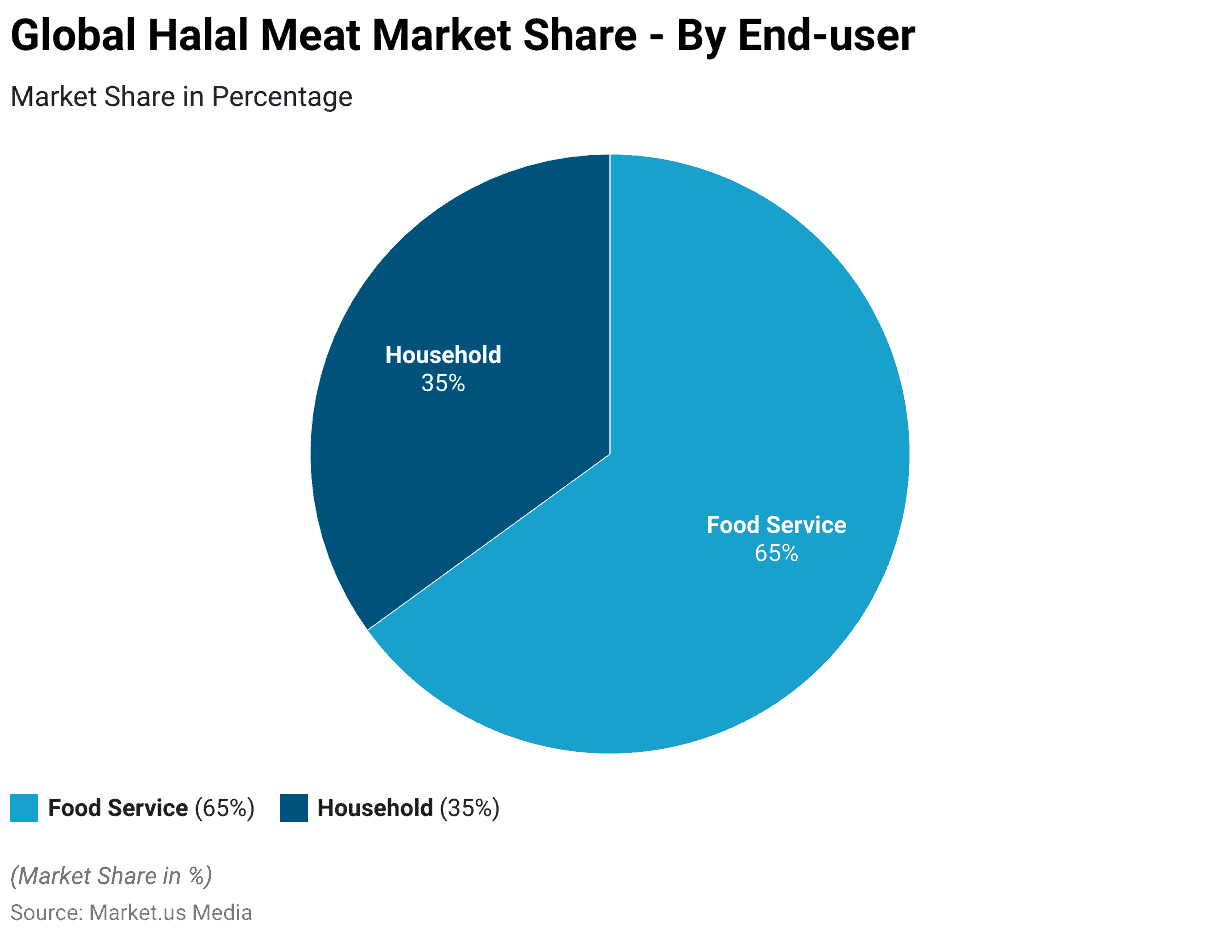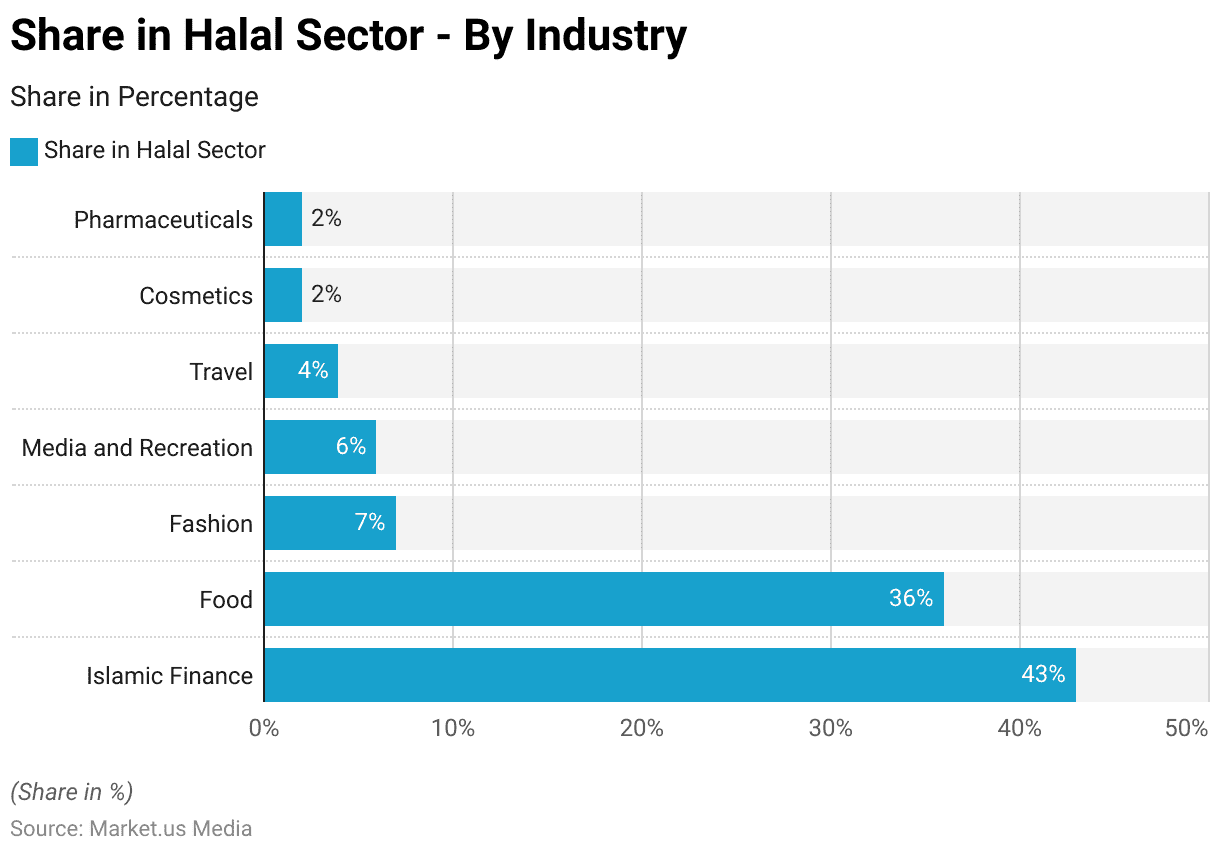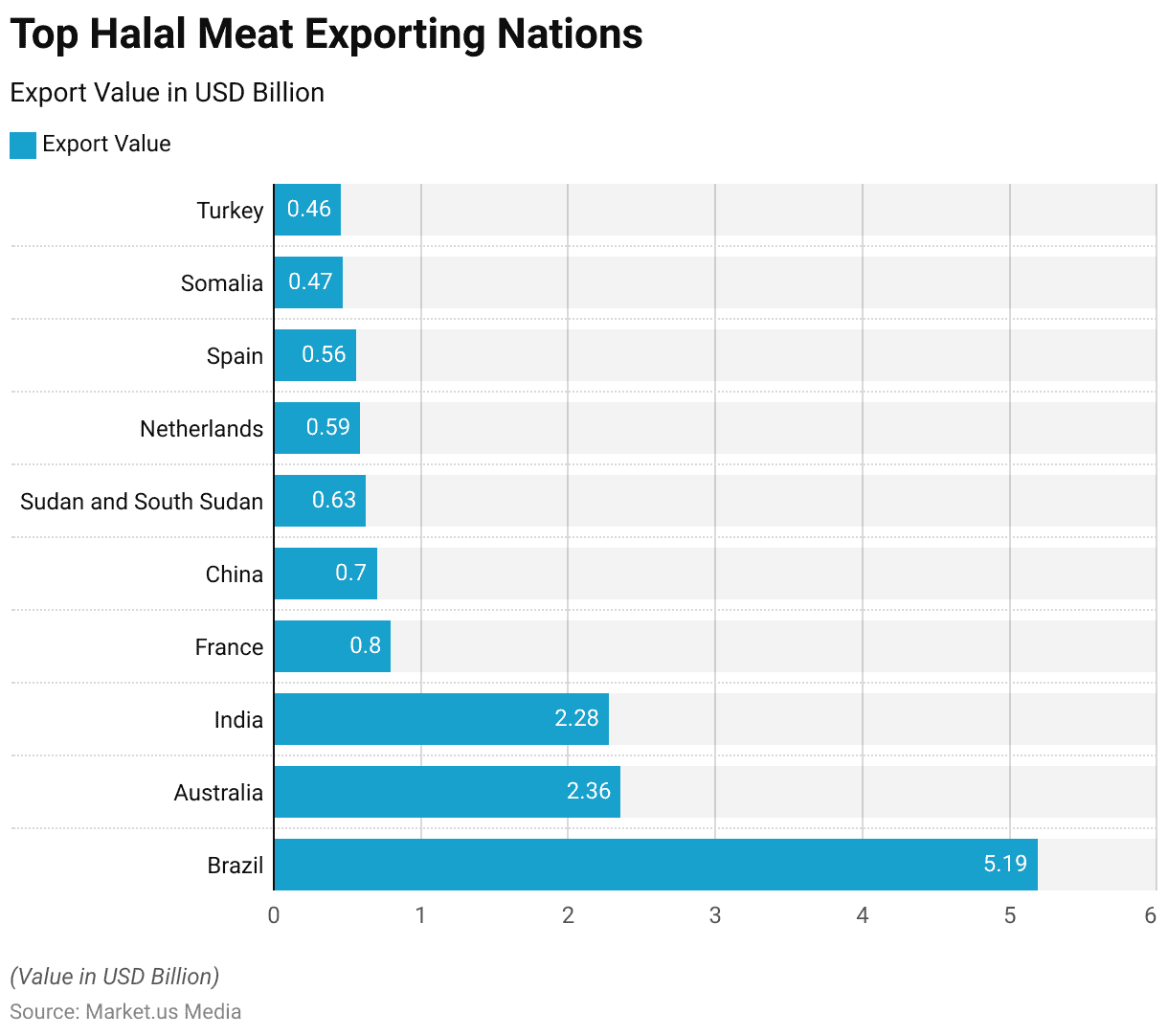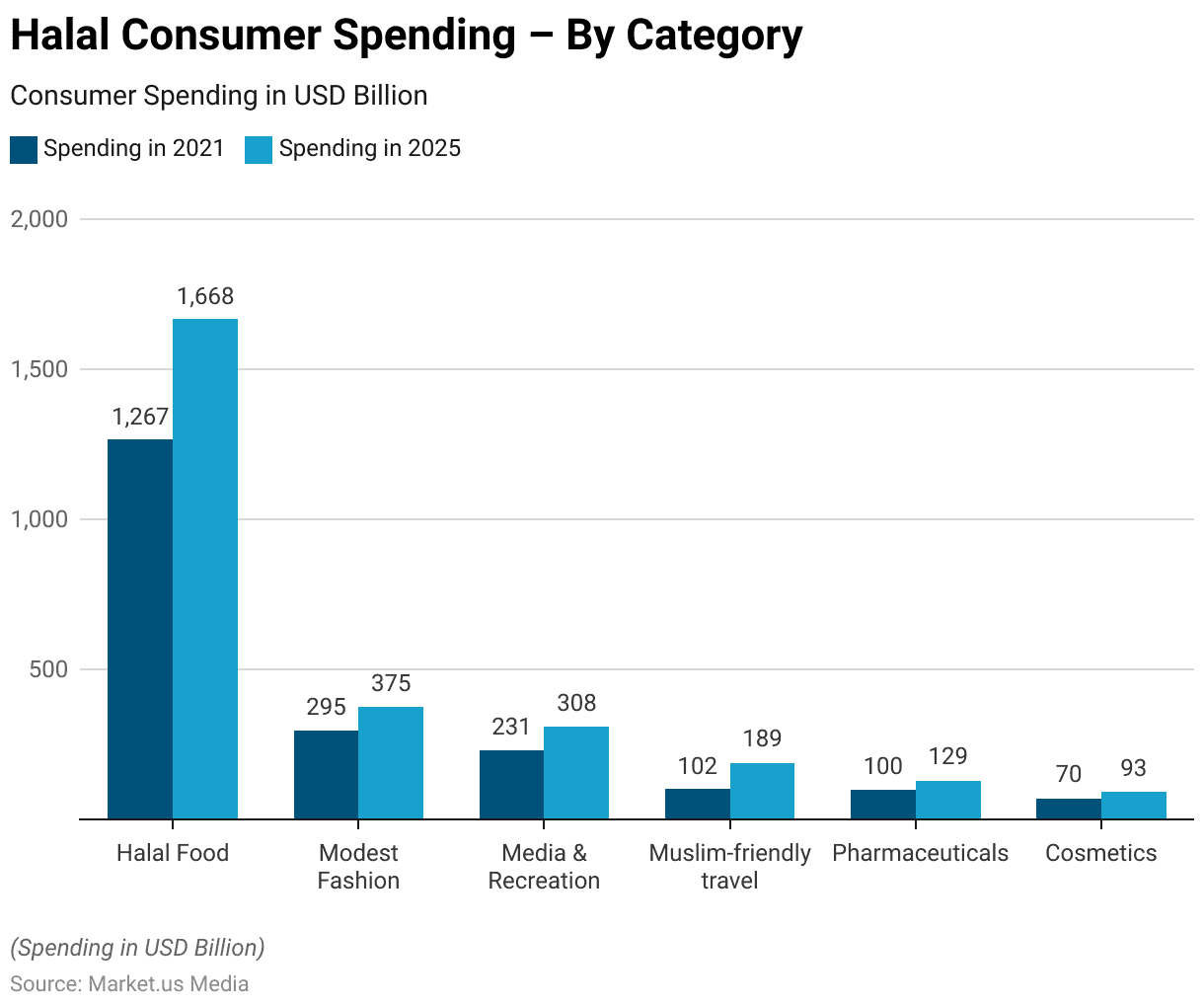Table of Contents
Introduction
According to Halal Meat Statistics, Halal meat is meat that’s prepared by Islamic dietary laws, which specify what’s permissible and prohibited for Muslims when it comes to consuming meat.
The meat must come from animals like cattle, sheep, goats, and poultry, which are considered Halal, while pork and its by-products are strictly forbidden (Haram) in Islamic dietary regulations.
Many countries have organizations or agencies that grant certifications for Halal meat products, ensuring that the meat is produced and processed following Halal standards.
It plays a vital role in the diets of Muslims worldwide and requires strict adherence to religious guidelines throughout the meat production process.
Editor’s Choice
- In 2023, the Halal meat market revenue stood at USD 294.4 billion.
- In terms of market share distribution among end-users, the food service sector dominates with a substantial 65% share, highlighting its prominent role in the market.
- In Saudi Arabia, the Saudi Arabian Standards Organization (SASO), established in 1972, has been designated to establish Halal standards, ensuring the authenticity of Halal food.
- Brazil stands as the leading exporter of halal meat among nations, boasting a substantial trade value of $5.19 billion.
- According to Volza’s Global Import data, the global import of Halal meat reached a total of 215,000 shipments.
- Brazil emerged as the leading exporter, with a significant export value of $16.2 billion.
- In 2021, the total value of global consumer spending within the Halal market across various categories was substantial, with Halal Food leading the way at $1,267 billion (or $1.267 trillion).

Halal Meat Market Overview
Global Halal Meat Market Size
- The global Halal meat market is on a steady growth trajectory, with revenues projected to increase over the coming years at a CAGR of 9.7%.
- In 2022, the market revenue stood at USD 265.9 billion and is expected to reach USD 294.4 billion in 2023.
- As we move towards 2027 and beyond, the market is forecasted to experience substantial expansion, reaching USD 442.8 billion in 2027, USD 490.4 billion in 2028, and USD 543.1 billion in 2029.
- The positive trend is set to persist, with projected revenues of USD 601.4 billion in 2030, USD 659.7 billion in 2031, and USD 723.7 billion in 2032, reflecting a robust and promising outlook for the global Halal meat market.

Global Halal Meat Market Share – By End-user
- In terms of market share distribution among end-users, the food service sector dominates with a substantial 65% share, highlighting its prominent role in the market.
- On the other hand, the household segment holds a significant but relatively smaller share of 35%.
- This division indicates that the food service industry plays a leading role in the utilization of the product or service, while households also contribute significantly to the market’s consumption, albeit to a somewhat lesser extent.

Halal Sector Market Share – By Industry
- Within the dynamic landscape of the Halal sector, various industries contribute to its growth and significance, each holding a distinct share.
- Islamic Finance takes the lead with the largest share, commanding 43% of the Halal market.
- This sector focuses on financial products and services adhering to Islamic principles, attracting a substantial portion of the Halal-conscious consumer base.
- The Food industry closely follows, accounting for 36% of the sector, as consumers prioritize Halal-compliant food and beverages.
- Fashion holds a 7% share, reflecting the growing demand for modest and Halal-compliant clothing options.
- Media and recreation contribute 6%, indicating the importance of Halal-friendly entertainment and leisure activities.
- Travel and Tourism represent 4%, as travelers seek experiences aligning with their Halal requirements.

History of Halal Certification
- In 1972, Singapore launched its Halal certification services under the Majlis Ulama Islam Singapore (MUIS), an organization founded in 1967, responsible for ongoing Halal certification oversight.
- In Saudi Arabia, the Saudi Arabian Standards Organization (SASO), established in 1972, has been designated to establish Halal standards, ensuring the authenticity of Halal food.
- Australia saw the introduction of Halal meat certification in 1977 by the Australian Federation of Islamic Councils (AFIC), making it the inaugural and most seasoned certification body in the country for Halal products.
- Similarly, the Islamic Society of North America (ISNA) was founded in the United States in 1981, holding recognition from JAKIM and currently collaborating with the Islamic Food and Nutrition Council of America (IFANCA) as an accrediting body for the development of Halal standards in the United States.
Top Halal Meat Exporting Nations
- Brazil stands as the leading exporter of halal meat among nations, boasting a substantial trade value of $5.19 billion.
- Following closely behind, Australia secures the second position with exports worth $2.36 billion, while India trails in third place with $2.28 billion.
- Other notable contributors to the global halal meat export market include France with $0.8 billion, China with $0.7 billion, Sudan and South Sudan combined at $0.63 billion, the Netherlands at $0.59 billion, Spain at $0.56 billion, Somalia at $0.47 billion, and Turkey at $0.46 billion.

Export of Halal Meat to OIC countries
- In the year 2019, several countries made substantial contributions to the export of halal meat to nations within the Organization of Islamic Cooperation (OIC).
- Brazil emerged as the leading exporter, with a significant export value of $16.2 billion.
- India closely followed with an impressive export value of $14.4 billion, while the United States secured the third position with exports worth $13.8 billion.
- Russia and Argentina also made notable contributions, with export values of $11.19 billion and $10.2 billion, respectively.

Top Halal Meat-Importing Nations
- According to Volza’s Global Import data, the global import of Halal meat reached a total of 215,000 shipments.
- These shipments were sourced from 722 different suppliers and received by 6,705 importers worldwide.
- India, Pakistan, and Brazil emerged as the primary countries from which the world imports the majority of its Halal meat.
- Vietnam took the lead as the largest importer of Halal meat, with a substantial 70,738 shipments.
- Malaysia secured the second position with 23,133 shipments, while the United Arab Emirates claimed the third spot with 19,691 shipments.
Halal Consumer Spending Statistics
- A 2016 global survey by Frost & Sullivan revealed that Halal consumers worldwide collectively spent a substantial $2 trillion, covering food, beverages, and various lifestyle aspects.
- This trend indicates that the influence of the Halal industry goes beyond food products, expanding into sectors like tourism, pharmaceuticals, cosmetics, and more.
- As consumer demand continues to rise, the Halal market diversifies, encompassing various industries such as healthcare, toiletries, and logistics, among others.
- For instance, in 2016, the tourism sector alone saw Halal consumers spending $169 billion. As projected, this figure reached $283 billion in 2022, highlighting the dynamic and expanding nature of the Halal industry driven by consumers embracing Halal principles in various aspects of their lives.
Halal Consumer Spending – By Category
- In 2021, the total value of global consumer spending within the Halal market across various categories was substantial, with Halal Food leading the way at $1,267 billion (or $1.267 trillion).
- This was followed by Modest Fashion at $295 billion, Media & Recreation at $231 billion, Muslim-friendly travel at $102 billion, Pharmaceuticals at $100 billion, and Cosmetics at $70 billion.
- The Halal market encompassed a diverse range of industries, reflecting the significance of Halal principles in consumers’ lives.
- Looking ahead to 2025, the forecast indicates a significant expansion in Halal consumer spending across these categories.
- Halal Food is expected to reach $1,668 billion, showing continued growth in this fundamental category.
- Modest Fashion is projected to grow to $375 billion, reflecting the increasing demand for modest clothing options.
- Media & Recreation is estimated to rise to $308 billion, highlighting the significance of Halal-friendly entertainment and leisure activities.
- Muslim-friendly travel is forecasted to increase to $189 billion, demonstrating the growing interest in travel experiences that align with Halal requirements.
- Pharmaceuticals are expected to reach $129 billion, while Cosmetics are projected to grow to $93 billion.

Consumer Preferences on Halal Meat
- A significant majority of individuals who are aware of Halal dietary practices abstain from consuming Halal foods, citing two primary reasons: either they do not adhere to the Islamic faith (64%) or they lack sufficient knowledge about Halal-certified foods (61%).
- Among Americans who are familiar with Halal, there is a prevailing belief that Halal-certified food products are more humane (44%), offer greater freshness (42%), and are healthier (41%) compared to non-Halal-certified foods.
- Consumers who are knowledgeable about Halal guidelines tend to prioritize nutritional content (81%) and ingredient transparency (76%) when shopping for food, distinguishing them from those less acquainted with Halal practices (74% and 62%, respectively).
- However, even among those who actively seek Halal-certified products, there is a notable challenge in locating them.
Discuss your needs with our analyst
Please share your requirements with more details so our analyst can check if they can solve your problem(s)



